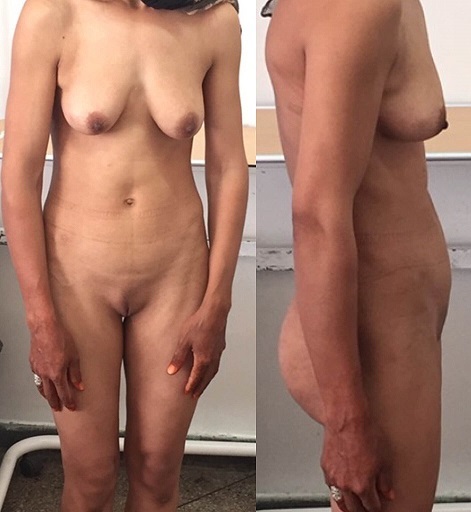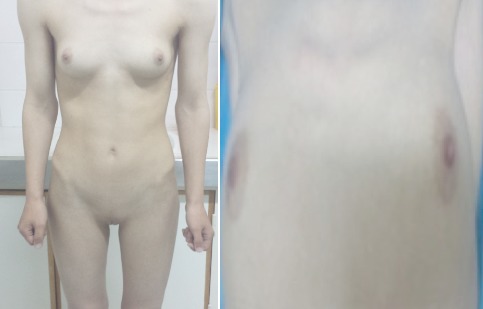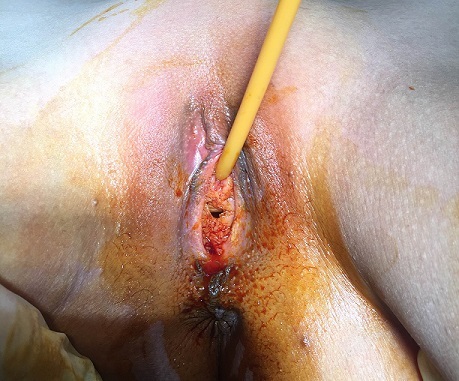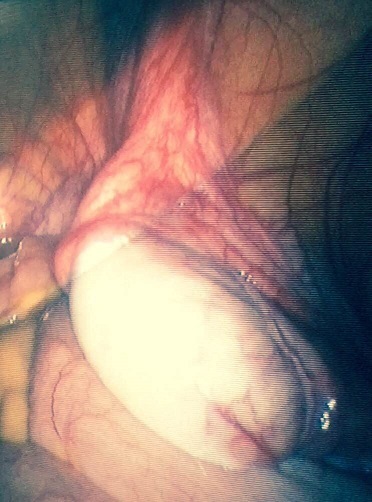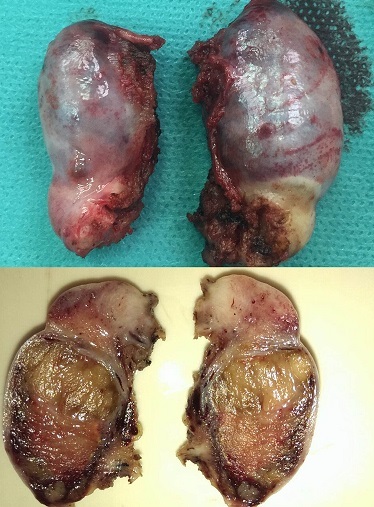Androgen insensitivity syndrome pathophysiology: Difference between revisions
Jump to navigation
Jump to search
| Line 11: | Line 11: | ||
===Genetics=== | ===Genetics=== | ||
*AIS is an X-linked disorder. <ref name="pmid28670533">{{cite journal |vauthors=Akella RR |title=Mutational Analysis of Androgen Receptor Gene in Two Families with Androgen Insensitivity |journal=Indian J Endocrinol Metab |volume=21 |issue=4 |pages=520–523 |year=2017 |pmid=28670533 |pmc=5477437 |doi=10.4103/ijem.IJEM_345_16 |url=}}</ref> | |||
*Spontaneous mutations in the androgen receptor (AR) gene results in Androgen insensitivity syndrome even without any family history. <ref name="pmid28670533">{{cite journal |vauthors=Akella RR |title=Mutational Analysis of Androgen Receptor Gene in Two Families with Androgen Insensitivity |journal=Indian J Endocrinol Metab |volume=21 |issue=4 |pages=520–523 |year=2017 |pmid=28670533 |pmc=5477437 |doi=10.4103/ijem.IJEM_345_16 |url=}}</ref> | |||
*The development of Androgen insensitivity syndrome is a result of genetic mutations of the androgen receptor (AR) gene located on the chromosome Xq11-12. <ref name="pmid24339553">{{cite journal |vauthors=Kota SK, Gayatri K, Kota SK, Jammula S |title=Genetic analysis of a family with complete androgen insensitivity syndrome |journal=Indian J Hum Genet |volume=19 |issue=3 |pages=355–7 |year=2013 |pmid=24339553 |pmc=3841565 |doi=10.4103/0971-6866.120820 |url=}}</ref> | *The development of Androgen insensitivity syndrome is a result of genetic mutations of the androgen receptor (AR) gene located on the chromosome Xq11-12. <ref name="pmid24339553">{{cite journal |vauthors=Kota SK, Gayatri K, Kota SK, Jammula S |title=Genetic analysis of a family with complete androgen insensitivity syndrome |journal=Indian J Hum Genet |volume=19 |issue=3 |pages=355–7 |year=2013 |pmid=24339553 |pmc=3841565 |doi=10.4103/0971-6866.120820 |url=}}</ref> | ||
*Different mutations in the androgen receptor (AR) gene leads to varied clinical phenotypes. <ref name="pmid26806084">{{cite journal |vauthors=Li L, Liu WM, Liu MX, Zheng SQ, Zhang JX, Che FY, Liu SG |title=A missense mutation in the androgen receptor gene causing androgen insensitivity syndrome in a Chinese family |journal=Asian J. Androl. |volume=19 |issue=2 |pages=260–261 |year=2017 |pmid=26806084 |pmc=5312231 |doi=10.4103/1008-682X.172647 |url=}}</ref> <ref name="Brinkmann2001">{{cite journal|last1=Brinkmann|first1=Albert O.|title=Molecular basis of androgen insensitivity|journal=Molecular and Cellular Endocrinology|volume=179|issue=1-2|year=2001|pages=105–109|issn=03037207|doi=10.1016/S0303-7207(01)00466-X}}</ref> | *Different mutations in the androgen receptor (AR) gene leads to varied clinical phenotypes. <ref name="pmid26806084">{{cite journal |vauthors=Li L, Liu WM, Liu MX, Zheng SQ, Zhang JX, Che FY, Liu SG |title=A missense mutation in the androgen receptor gene causing androgen insensitivity syndrome in a Chinese family |journal=Asian J. Androl. |volume=19 |issue=2 |pages=260–261 |year=2017 |pmid=26806084 |pmc=5312231 |doi=10.4103/1008-682X.172647 |url=}}</ref> <ref name="Brinkmann2001">{{cite journal|last1=Brinkmann|first1=Albert O.|title=Molecular basis of androgen insensitivity|journal=Molecular and Cellular Endocrinology|volume=179|issue=1-2|year=2001|pages=105–109|issn=03037207|doi=10.1016/S0303-7207(01)00466-X}}</ref> | ||
Revision as of 20:30, 23 August 2017
|
Androgen insensitivity syndrome Microchapters |
|
Differentiating Androgen insensitivity syndrome from other Diseases |
|---|
|
Diagnosis |
|
Treatment |
|
Case Studies |
|
Androgen insensitivity syndrome pathophysiology On the Web |
|
American Roentgen Ray Society Images of Androgen insensitivity syndrome pathophysiology |
|
Directions to Hospitals Treating Androgen insensitivity syndrome |
|
Risk calculators and risk factors for Androgen insensitivity syndrome pathophysiology |
Editor-In-Chief: C. Michael Gibson, M.S., M.D. [1]; Associate Editor(s)-in-Chief:
Overview
Pathophysiology
Pathogenesis
- It is thought that Androgen insensitivity syndrome is caused due to hormone resistance which may be due to defective androgen receptor (AR) function by either abnormal AR binding, decreased receptor binding, or impaired androgen receptor (AR) binding. [1] [2] [3] [4]
Genetics
- AIS is an X-linked disorder. [5]
- Spontaneous mutations in the androgen receptor (AR) gene results in Androgen insensitivity syndrome even without any family history. [5]
- The development of Androgen insensitivity syndrome is a result of genetic mutations of the androgen receptor (AR) gene located on the chromosome Xq11-12. [6]
- Different mutations in the androgen receptor (AR) gene leads to varied clinical phenotypes. [7] [8]
- There have been more than 400 different AR mutations reported. [9] [10]
Associated Conditions
Gross Pathology
- Complete androgen insensitivity syndrome in a 30 years old woman who presented primary amenorrhea.[11]. [12]
-
Front and side view of the patient
-
Normal female morphotype but absence of pubic and axillary hair
-
Clinical aspect of the vagina
-
Intra- abdominal testes - Laparoscopic aspect
-
The excised testis - Macroscopic aspect
Microscopic Pathology
- Histopathology shows two testes with atrophic seminiferous tubules containing only sertoli cells, associated to a Leydig cells hyperplasia.[12]
- On histological examination, the well-limited nodule circumscribed by a thin capsule consists of atrophic servolian tubes with a very small interstitial tissue with rare leydig cells. This nodule corresponds to a well differentiated tumor with sertoli-leydig cells. [11]
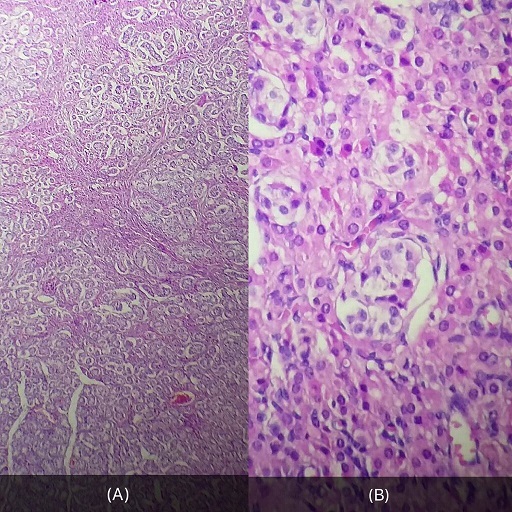
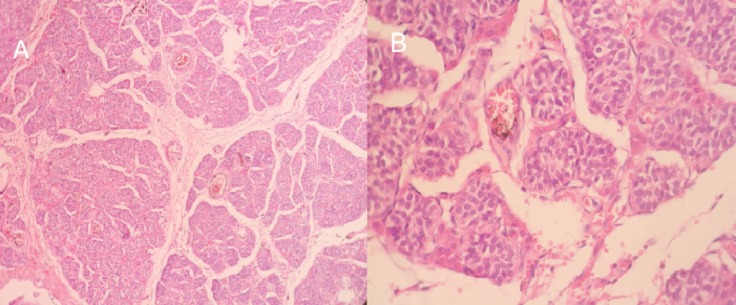
References
- ↑ Flier, Jeffrey S.; Underhill, Lisa H.; Griffin, James E. (1992). "Androgen Resistance — The Clinical and Molecular Spectrum". New England Journal of Medicine. 326 (9): 611–618. doi:10.1056/NEJM199202273260906. ISSN 0028-4793.
- ↑ Pagon RA, Adam MP, Ardinger HH, Wallace SE, Amemiya A, Bean L, Bird TD, Ledbetter N, Mefford HC, Smith R, Stephens K, Gottlieb B, Trifiro MA. PMID 20301602. Vancouver style error: initials (help); Missing or empty
|title=(help) - ↑ Brown, Terry R.; Maes, Marc; Rothwell, Stephen W.; Migeon, Claude J. (1982). "Human Complete Androgen Insensitivity with Normal Dihydrotestosterone Receptor Binding Capacity in Cultured Genital Skin Fibroblasts: Evidence for a Qualitative Abnormality of the Receptor*". The Journal of Clinical Endocrinology & Metabolism. 55 (1): 61–69. doi:10.1210/jcem-55-1-61. ISSN 0021-972X.
- ↑ Griffin, James E. (1979). "Testicular Feminization Associated with a Thermolabile Androgen Receptor in Cultured Human Fibroblasts". Journal of Clinical Investigation. 64 (6): 1624–1631. doi:10.1172/JCI109624. ISSN 0021-9738.
- ↑ 5.0 5.1 Akella RR (2017). "Mutational Analysis of Androgen Receptor Gene in Two Families with Androgen Insensitivity". Indian J Endocrinol Metab. 21 (4): 520–523. doi:10.4103/ijem.IJEM_345_16. PMC 5477437. PMID 28670533.
- ↑ Kota SK, Gayatri K, Kota SK, Jammula S (2013). "Genetic analysis of a family with complete androgen insensitivity syndrome". Indian J Hum Genet. 19 (3): 355–7. doi:10.4103/0971-6866.120820. PMC 3841565. PMID 24339553.
- ↑ Li L, Liu WM, Liu MX, Zheng SQ, Zhang JX, Che FY, Liu SG (2017). "A missense mutation in the androgen receptor gene causing androgen insensitivity syndrome in a Chinese family". Asian J. Androl. 19 (2): 260–261. doi:10.4103/1008-682X.172647. PMC 5312231. PMID 26806084.
- ↑ Brinkmann, Albert O. (2001). "Molecular basis of androgen insensitivity". Molecular and Cellular Endocrinology. 179 (1–2): 105–109. doi:10.1016/S0303-7207(01)00466-X. ISSN 0303-7207.
- ↑ Davey RA, Grossmann M (2016). "Androgen Receptor Structure, Function and Biology: From Bench to Bedside". Clin Biochem Rev. 37 (1): 3–15. PMC 4810760. PMID 27057074.
- ↑ Mongan NP, Tadokoro-Cuccaro R, Bunch T, Hughes IA (2015). "Androgen insensitivity syndrome". Best Pract. Res. Clin. Endocrinol. Metab. 29 (4): 569–80. doi:10.1016/j.beem.2015.04.005. PMID 26303084.
- ↑ 11.0 11.1 11.2 Souhail R, Amine S, Nadia A, Tarik K, Khalid EK, Abdellatif K, Ahmed A (2016). "Complete androgen insensitivity syndrome or testicular feminization: review of literature based on a case report". Pan Afr Med J. 25: 199. doi:10.11604/pamj.2016.25.199.10758. PMC 5326263. PMID 28270903.
- ↑ 12.0 12.1 12.2 Lachiri B, Hakimi I, Boudhas A, Guelzim K, Kouach J, Oukabli M, Rahali DM, Dehayni M (2015). "[Complete androgen insensitivity syndrome: report of two cases and review of literature]". Pan Afr Med J (in French). 20: 400. doi:10.11604/pamj.2015.20.400.6760. PMC 4524922. PMID 26301004.
